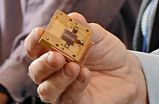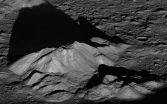(Press-News.org) Scientists know what the universe looked like when it was a baby. They know what it looks like today. What they don't know is how it looked in its youth. Thanks to technological advances, however, scientists hope to complete the photo album and provide a picture of how the cosmos developed into the kind of place that could support life like that found on Earth.
They plan to gather these never-before-obtained insights with a potentially "game-changing" instrument that is expected to be 10,000 times more sensitive than the current state-of-the-art.
The instrument is being designed to gather data of objects so distant from Earth that they no longer can be observed in visible light, only in the infrared bands of the electromagnetic spectrum. In particular, this instrument, called a spectrometer, will measure the properties of the infrared light to identify the object's composition and other physical properties.
Just as impressive, the aptly named MicroSpec would be able to perform these highly sensitive observations from a very small platform -- so small, in fact, that all its components would fit onto a silicon wafer measuring just four inches in diameter.
Now under development by engineers and scientists at the Goddard Space Flight Center in Greenbelt, Md., the instrument is a strong contender for future flight missions in astrophysics and Earth science, said astrophysicist Harvey Moseley, who is leading the instrument-development effort. "It's quite a new and, we think, revolutionary concept," he said. "If we can prove it, everyone will want it."
Stars to Hemoglobin
Although the technology could help answer a plethora of science questions, it is ideally suited for studying the evolution of the universe and by extension, humanity's place in it.
Past NASA missions, including the Goddard-developed Cosmic Background Explorer and the Wilkinson Microwave Anistropy Probe, studied the infant universe. They gathered information about the primordial light created during the universe's creation. Both detected tiny temperature differences, which pointed to density differences that ultimately gave rise to the first stars and galaxies formed 400,000 million years after the Big Bang.
However, scientists have yet to study these objects with great precision. They also have not studied light emitted by the life-sustaining elements created in these first stars and later distributed across the universe in stellar explosions.
"Right after the Big Bang, the only elements that were really present in any abundance were hydrogen and helium," Moseley said. "The formation of stars and the nuclear reaction that took place inside these first stars have created essentially all the elements that constitute the things that we see around here -- the carbon in our bodies and the iron and hemoglobin in our blood. All these elements were formed in the many generations of stars that have been born and have died since the Big Bang."
By building an instrument like MicroSpec, and studying this specific era in the universe's nearly 14-billion-year history, scientists will "get a very clear picture of how the universe developed into the kind of place that could support life like us," Moseley added.
Unprecedented Instrument
Not only is the science unprecedented, so is the instrument, said Wen-Ting Hsieh, a Goddard Detector Development Laboratory engineer who has been working with Moseley since 2009 to advance the technology in preparation for a future mission. "The most important thing is it is small and it's super-sensitive."
In essence, Moseley, Hsieh, and their NASA Jet Propulsion Laboratory and CalTech University collaborators have found a way to dramatically shrink the size of the instrument. Compared with traditional spectrometers, which typically are table sized, the entire MicroSpec package of components, including its detectors, optics, and filters, would all be arranged on a thin silicon wafer measuring about 400 microns in thickness -- four times the width of a human hair -- and four inches in diameter.
"The idea was to get everything closely integrated and you get devices that are higher performing," said Carl Stahle, a Goddard technologist and the new business lead for the Instrument Systems and Technology Division at Goddard. And because the components are assembled on silicon, MicroSpec can be mass-produced, just like the silicon chips used in computers and other electronic equipment.
Therefore, NASA could produce multiple devices and assemble them as one compact instrument. In addition to providing increased sensitivity, MicroSpec would reduce the amount of time to observe objects in the sky because more light-detection capabilities would be built into the instrument. "The key is understanding what you can do on the silicon wafer. That's your instrument on a chip," Stahle explained.
Also contributing to MicroSpec's increased sensitivity -- estimated to be 10,000 times better than current state-of-the-art instruments -- is the degree to which it would be cooled. To detect far infrared light, instruments must be cooled to frigid temperatures to prevent instrument-generated heat from swamping the faint infrared signal. Therefore, the colder the instrument, the better the signal it receives. Moseley and team plan to employ an advanced Goddard-developed cooling system that would chill MicroSpec to just a tenth of a degree above absolute zero (-459.67 degrees Fahrenheit).
The future looks good for MicroSpec, Stahle said. Its sensitivity and small size make it suitable for all types of missions, everything from large observatories, like the Hubble Space Telescope, to suborbital missions carried out on balloons and aircraft. "It's very flexible, adaptable. Any time we can get a factor-of-10 improvement in power, mass, and volume, we think it's great. But this instrument is promising orders of magnitude performance. That's almost unheard of. I think anyone would say that's extraordinary."
INFORMATION:
Scientists hope to get glimpse of adolescent universe from revolutionary instrument-on-a-chip
2011-07-01
ELSE PRESS RELEASES FROM THIS DATE:
Kirstie and Phil Launch House Hunter App
2011-07-01
Kirstie Allsopp and Phil Spencer, the TV property gurus, have launched new research revealing UK home hunters overspent their combined budgets by a staggering GBP3.7 billion last year, despite falling house prices and what should be a buyers' market.
The survey of 2,000 home buyers, announced to coincide with the launch of the new iPhone app 'Kirstie & Phil's House Hunter', has revealed that almost half (49 per cent) blow their budget on average to the tune of over GBP10,000.
For one in ten home buyers (10 per cent) the situation is even more extreme, with finances ...
NASA's LRO mission gets a sunrise view of Tycho crater's peak
2011-07-01
On June 10, 2011, NASA's Lunar Reconnaissance Orbiter spacecraft pointed the LRO Camera NACs to capture a dramatic sunrise view of Tycho crater.
A very popular target with amateur astronomers, Tycho is located at 43.37°S, 348.68°E, and is about 51 miles (82 km) in diameter. The summit of the central peak is 1.24 miles (2 km) above the crater floor. The distance from Tycho's floor to its rim is about 2.92 miles (4.7 km).
Many rock fragments ("clasts") ranging in size from some 33 feet (10 m) to hundreds of yards are exposed in the central peak slopes. Were these distinctive ...
Confused.com Designs New Pothole Warning Sign
2011-07-01
Confused.com has designed a new road sign, specifically to alert road users to the UK's two million potholes*. The road sign is the first of its kind and the car insurance expert is petitioning to urge the Department for Transport to introduce it to roads across the UK.
A constant source of frustration for drivers, the sign has been developed in response to recent findings that even with sufficient budgets; it would take councils at least 11 years to repair the UK's damaged roads**. With this in mind, 82% of drivers would like to see a road sign dedicated to potholes. ...
Study uncovers novel genetic variation linked to increased risk of sudden cardiac arrest
2011-07-01
LOS ANGELES – June 30, 2011 – A study by a global consortium of physician-scientists has identified a genetic variation that may predispose people to double the risk of having a sudden cardiac arrest, a disorder that gives little warning and is fatal in about 95 percent of cases. Although previous, smaller studies have identified some genes with a potential association with sudden cardiac arrest, this is the first study large enough to enable scientists to apply results to the general population. Findings are published today by the Public Library of Science (PloS Genetics).
"We ...
Georgetown research identifies key reasons racial disparities exist in emergent stroke treatment
2011-07-01
Washington, DC – African-Americans are less likely than whites to receive critical stroke treatment primarily because they do not get to a hospital soon enough for time-sensitive treatment and because of preexisting medical conditions. For patients who are eligible for treatment, no racial disparity was found.
Those are the findings of a new Georgetown University Medical Center study involving the review of almost 1,000 patient records from all seven acute care hospitals in Washington, DC. The new study will be published in the June 30th issue of American Stroke Association's ...
Happy Employees Need a Voice Says Reed.co.uk
2011-07-01
Whilst pay, perks and a pleasant working environment all score highly, being kept in the loop with high levels of communication is the single most important factor in keeping UK workers content within their jobs.
The survey conducted by reed.co.uk, which polled more than 2,500 UK workers, revealed that strong communication (87% of respondents), opportunities for career advancement (86%) and job security (85%) are amongst the most important factors contributing to staff happiness, whilst training (81%) and recognition of a job well done (77%) also influence job satisfaction. ...
Women win out in gastrointestinal surgery
2011-07-01
In the first study to consider the impact of gender on patient outcomes in major gastrointestinal surgeries, researchers at UC San Diego Health System have found that women are more likely to survive after the procedure than men. The pattern is even more pronounced when comparing women before menopause with men of the same age.
Results, now published online in the Journal of Surgical Research in a paper titled "The Battle of the Sexes: Women Win Out in Gastrointestinal Surgery," shed light on major differences between patients which impact treatment success, and open ...
Assessing agroforestry's advantages
2011-07-01
MADISON, WI, JUNE 30, 2011 -- Agroforestry, the deliberate placement of trees into crop and livestock operations, can help capture substantial amounts of carbon on agricultural lands while providing production and conservation benefits. However, we currently lack tools for accurately estimating current and projected carbon values in these systems.
In North America, windbreaks are an effective carbon-capturing option. Only occupying about 2 to 5% of the land, windbreaks also help protect crops and livestock, as well as reduce wind erosion. They provide a means to increase ...
Account Ability Offers Free W2 & 1099 Reporting Capability to Software Developers!
2011-07-01
IDMS Account Ability has launched a Wage and Information Reporting Data Module ("AADM") that is free to all software developers. AADM merges data extracts from any authored application with Account Ability's library of government approved information returns and annual wage reports. AADM supports the entire family of Information Returns (1097-BTC, 1098, 1098-C, 1098-E, 1098-T, 1099-A, 1099-B, 1099-C, 1099-CAP, 1099-DIV, 1099-G, 1099-H, 1099-INT, 1099-K, 1099-LTC, 1099-MISC, 1099-OID, 1099-PATR, 1099-Q, 1099-R, 1099-S, 1099-SA, 3921, 3922, 5498, 5498-ESA, 5498-SA, ...
Foot positioning during walking and running may influence ankle sprains
2011-07-01
The position of the foot just before ground contact during running and walking may put people at risk for ankle sprains, according to a new study published by a University of Georgia kinesiology researcher.
The results of the study, which appear in the June online edition of the American Journal of Sports Medicine, found that people who have a history of repetitive ankle sprains demonstrated lower clearance heights between their feet and the floor during running and pointed their toes down more during walking. Ankle sprains are the most common sports-related injury, and ...



